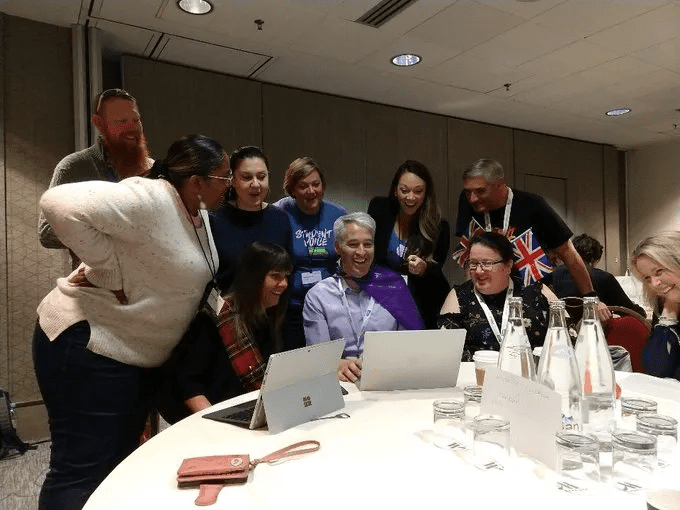As we look at, analyze, and consider the impact of the platforms we use it is critical to consider the actual educator experience. No one technology tool or application is going to work perfectly for all students, but the key is how it might dismantle any potential barriers to access right from the start. As I shared in Part 1 of this series Reading Progress most definitely does the dismantling of both inaccessibility and lack of opportunity for learners when it comes to reading. In order to fully grasp the potential impact on learners, I wanted to incorporate the voice and experience of not only a classroom educator but an educator that is using Reading Progress with their students on a regular basis. I had the privilege of chatting with Luis Oliveira, originally from Portugal, who is an educator of 31 years in Middletown, Rhode Island. Luis is the Director of Unified Arts, an ELL Teacher, and Technology Innovation Coach at Middletown High School in Middletown, Rhode Island. He is also an adjunct professor at Roger Williams University. I wanted to chat with Luis about his use of Reading Progress since he is also a staunch advocate for accessibility and inclusion when it comes to the use of technology and due to his breadth of expertise across a myriad of technology platforms.

Ken: What first exposed you to Reading Progress?
Luis: I first learned about Reading Progress from Mike Tholfsen at E2 in Paris. He showed a group of us a preview of Reading Progress and we fell in love with it immediately. He helped me see the possibilities of the program and how it could impact my students, especially since I primarily work with students that are learning English as their second language. I became involved in the associated Microsoft Teams groups and was selected to participate in the Beta testing.
Ken: When you became more familiar with the platform how did you connect it to your learners?
Luis: I began using Reading Progress with my English Learners (“ELs”) as a way of introducing new reading assignments from Newsela. I had the students read the excerpts from the articles for background knowledge while also assessing their reading. In addition, the readings introduced cultural and social-emotional topics that we were covering such as Ramadan, wellness, meditation, etc. I’m currently exploring using Reading Progress in other languages. This will be very helpful in determining literacy challenges with some of my new students.
Ken: What are some of the additional ways you use Reading Progress? How have you seen it impact student learning?
Luis: One of the ways I currently use it with English Learners is for progress monitoring including correct words per minute, insertions, omissions, mispronunciations, repetitions, and self-corrections. By doing this the students can see and monitor their progress. We can use this feedback to further discuss their individual needs during the times I am conferencing with the students. This also helps me to see patterns of errors to help develop whole group and individual lessons. For example, multiple students making the same error with the phoneme /f/ in words like fish, giraffe tough, and/or phone (Graphemes f, ff, ph, gh). I then use additional features like Insights to show the student’s patterns, growth over time, etc. The Word Cloud is a great way to see individual and whole class issues. I have found these approaches to be very effective since my students are more willing to read when they are in a safe environment. My students like the fact that they have multiple attempts to record their responses. The “perfectionists” in the group feel more comfortable. By recording multiple times the students are in a sense practicing much more than they would with traditional monitoring tools.
Ken: What is one strategy that you would suggest a teacher look to do when utilizing Reading Progress?
Luis: Teachers can use Reading Progress to introduce cultural topics to their students while providing background knowledge for future assignments. My ELs come from all over the world so these topics are opportunities for the students to share aspects of their cultures with their peers. When students see topics they can connect with they are more likely to engage and to want to share their personal experiences. Teachers can find and incorporate readings that are culturally relevant to their students’ experiences and make them part of their Reading Progress bank.
Ken: Are there any additional things to be aware of?
Luis: Reading Progress is a tremendous time-saver. Instead of having to assess each student individually, teachers can have students record their responses and analyze them at a later time. The time saved is time that can be spent with students during class time to work on areas of need and growth. Having the saved recordings of responses makes it easier to go back and assess/analyze carefully instead of on the spot. The recordings also make it easier to collaborate with Reading Specialists and Special Education teachers.
Ken: What is your hope around the impact of the platform for your students? Other’s who are or are considering utilizing it?
Luis: My hope is that the students will be able to see their individual progress in reports in the near future. I share the reports with the students and we discuss them and determine ways the students can improve, but once the students can also see their own progress they hopefully will be motivated with their success. Students don’t always believe that they are improving. Seeing is believing. I have seen this with the Flipgrid Mixtapes and I feel confident that the same results will occur with Reading Progress. I believe more opportunities for reading practice will also be opportunities for vocabulary building thus leading to comprehension.
Ken: Any final thoughts to share and thank you so much for your time discussing Reading Progress with me.
Luis: We need to give our students experiences where they can be successful. The Reading Progress platform does just that. Hopefully, we can help students develop a love for reading instead of creating another group of students who hate it. Being forced to read in front of a class before I was ready, made me hate reading. That is a “wound” that I am still trying to overcome. I don’t want to see another child feel like I did.
I’d like to personally thank Luis for sharing his experiences with Reading Progress and the impact it has had on both him and his learners. Also thank you all for your support in amplifying these posts around Reading Progress and Techquity. I look forward to sharing more in future posts on the real and relevant impact of techquity within our learning spaces.

